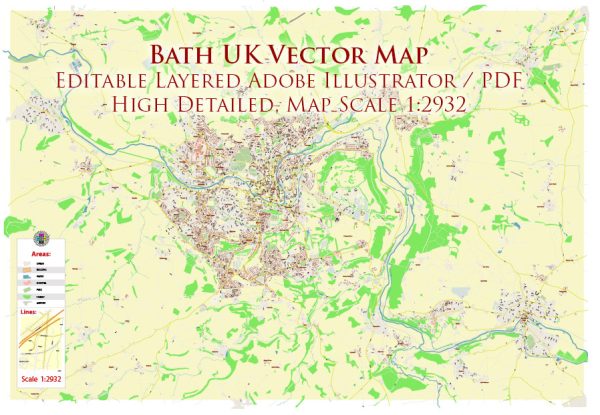Bath, located in the southwest of England, has a rich economic history that spans centuries.
Vectormap.Net provide you with the most accurate and up-to-date vector maps in Adobe Illustrator, PDF and other formats, designed for editing and printing. Please read the vector map descriptions carefully.
Here’s a brief overview of its economic development:
- Roman Period (43–410 AD): Bath’s economic history dates back to the Roman period when the city was known as Aquae Sulis. The Romans recognized the therapeutic value of the natural hot springs, and Bath became a popular spa and bathing destination. The construction of baths and other structures led to economic growth, with the city serving as a hub for trade and commerce.
- Medieval Period (410–1485): The medieval period saw the decline of Roman influence, and Bath became a small market town. The Abbey, founded in the 7th century, became a focal point for economic and social activities. The woolen cloth trade and the presence of a weekly market contributed to the town’s economic development.
- Tudor and Stuart Periods (1485–1714): During the Tudor and Stuart periods, Bath continued to grow in prominence. Queen Elizabeth I granted Bath city status in 1590. The city became known for its architecture and the Royal Crescent, a series of terraced houses designed by John Wood the Elder, which attracted the aristocracy. The hot springs continued to be a major draw, and tourism began to play a significant role in the local economy.
- 18th Century – Georgian Era: The 18th century marked a significant period in Bath’s economic history. The city became a fashionable spa resort, drawing visitors seeking health and leisure. The architecture flourished under the direction of architects like John Wood the Elder and John Wood the Younger. Bath’s economic prosperity was closely tied to the tourism industry, with the construction of elegant buildings, hotels, and assembly rooms.
- 19th Century: The Industrial Revolution had a profound impact on the British economy, but Bath remained somewhat insulated from the heavy industrialization that affected other cities. Instead, it continued to develop as a cultural and tourism center. The Great Western Railway’s arrival in 1840 improved accessibility, further boosting tourism and trade.
- 20th Century: Bath faced economic challenges in the early 20th century, particularly during the World Wars. The city experienced bombings during World War II, leading to damage to historic buildings. After the war, efforts were made to restore and preserve Bath’s architectural heritage, attracting tourists and bolstering the local economy.
- 21st Century: In the modern era, Bath’s economy remains diverse, with tourism, education, and healthcare playing crucial roles. The University of Bath, established in 1966, has become a major contributor to the local economy. The city’s UNESCO World Heritage status, awarded in 1987, continues to attract visitors interested in its historic architecture and cultural heritage.
Today, Bath is a thriving city that combines its historical charm with a vibrant economy, supported by tourism, education, and a mix of industries. The careful preservation of its architectural heritage has allowed Bath to maintain its unique character and economic appeal.


 Author: Kirill Shrayber, Ph.D.
Author: Kirill Shrayber, Ph.D.